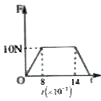A particle of mass 120g moving at speed of 750cm/s is acted upon by a variable forrenpposite to its direction of motion as shown in figure. If the velocity of the particle becomes 250cm/s along the direction of force, fund the value of time't' for which force acted.Solution in Telugu
Area of Ft graph = Impulse = Change in momentum

12(t+6)×10−2×10
=120×10−3(7.5+2.5)
∴t=18s
Similar Questions
A particle of mass 120 g moving at speed of 750 cm/s is acted upon by a variable force opposite to its direction of motion. If the velocity of the particle becomes 250 cm/s along the direction of force, find the value of time 't' for which acted.
View SolutionA particle of mass 120 g moving at speed of 750 cm/s is acted upon by a variable force opposite to its direction of motion. If the velocity of the particle becomes 250 cm/s along the direction of force, find the value of time 't' for which force acted.
View SolutionA particle of mass 1 kg has a velocity of 2m//s . A constant force of 2N acts on the particle for 1s in a direction perpendicular to its initial velocity. Find the velocity and displacement of the particle at the end of 1 s.
View SolutionA force acts on a particle moving at a relativistic speed in a direction perpendiculal' to its path. How will the particle move? Express the force in terms of the speed and of the radius of curvature of the path.
View SolutionA particle of mass 2kg moving with a velocity of 3m/s is acted upon by a force which changes its direction of motion by an angle of 90∘ without changing its speed. What is the magnitude of impulse experienced by the particle?
View SolutionA particle is moving under the influence of a force which is fixed in magnitude and acting at an angle theta in the direction of motion. The path described by the particle is
View SolutionA particle is moving under the influence of a force which is fixed in magnitude and acting at an angle theta in the direction of motion. The path described by the particle is
View SolutionA particle of mass 70 g moving at 50cms^(-1) is acted upon by a variable force as shown in the figure. What will be its speed once the force stops?
View Solution
